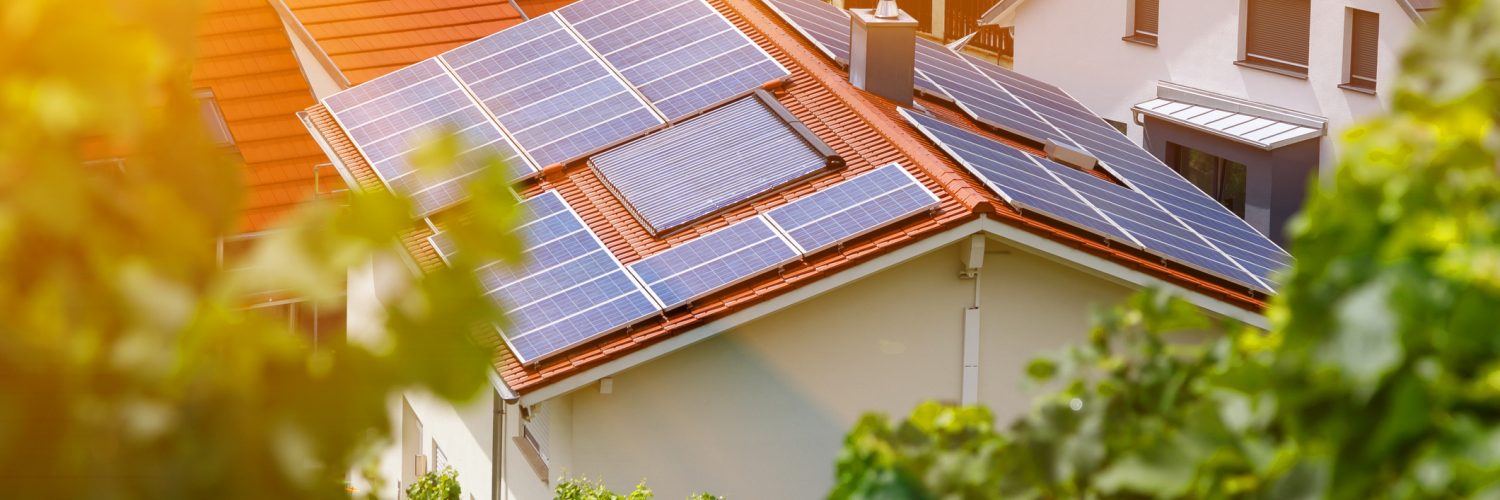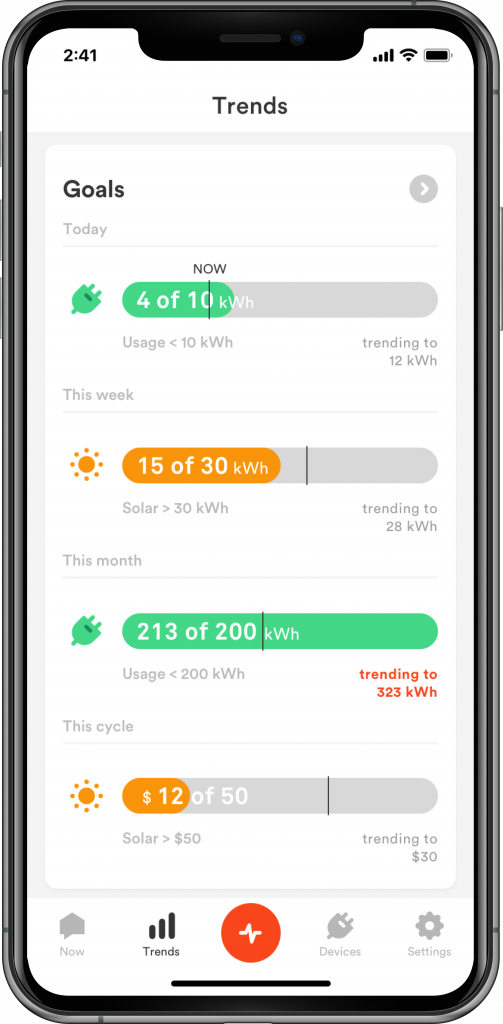With Federal tax breaks ending in 2021, it could be time for your home’s energy independence!
Climate change has prompted many of us to think about where the energy we use comes from and what impact it has on the world. About 60% of households still rely on energy from fossil fuels, but access to renewable energy sources has become easier. Solar energy can put you on a path to energy independence and tremendous cost savings while helping slow climate change. So whether you want to reduce your utility bills or your carbon footprint, a solar system for your home could be the right choice for you this Independence Day.
To understand the basic elements of solar energy for homes, let’s start with the ultimate power source: the sun. About 173,000 terawatts of solar power continuously reaches the Earth’s surface, making solar energy the most abundant energy resource on our planet. Solar panels rely on photovoltaic technology to absorb photons from sunlight to create an electric field. An inverter converts the direct current produced by the sun to alternating current, the standard for electric power in American homes. The inverter exports any surplus electricity to the grid, also, so the utility can pay you for your extra energy production. While solar energy technologies sound pretty simple, choosing a system that’s right for your home is more complicated.
Producing solar power for your house is like growing your own vegetables in your garden. You provide for yourself and can live more independently. But solar is a substantial investment and it’s not for every home. If your utility bills are low, or your local utility doesn’t have solar friendly policies, the investment in solar may not pay off for you.
You need to consider several factors, including the size and condition of your roof, its sun exposure, your electricity consumption currently and financial payoffs. Here are some steps that will help you make a good decision.
Step 1: Figure out your home’s solar potential
To get an initial idea about your roof’s solar potential, you can enter your address at Google Project Sunroof. It calculates the sunlight striking your roof, usable space for solar panels and estimated net savings over 20 years. One common misconception is that solar panels only pay off in hot, sunny parts of the country. To test this idea, look around your yard. Are there trees and other green plants? Plants use the sun’s energy to grow their leaves, so they are a good indicator of solar energy in your yard! Solar panels actually perform more efficiently in cooler temperatures. For another perspective on your home’s solar potential, check out solar resource maps from the National Renewable Energy Laboratory (NREL).
Step 2: See what your utility bill tells you
To evaluate whether solar is right for you, start with your utility bill. Is it high enough that a solar investment will pay off for you in a reasonable period of time? For most people, a utility bill tells you one basic fact: your monthly usage. But a high monthly electricity bill can be caused by many factors. What is using the most energy in your home? It could be an old appliance that needs updating or a device that’s running all the time in the background. Once those are eliminated, your need for solar energy could be less. Also, while you evaluate a solar investment, consider how much of your energy usage is electric versus another energy source like natural gas.
Step 3: Plan ahead
Will you be living in the same house in the next decade? A solar system is a big investment with a typical payback period of eight years. If you plan to move in the next couple of years, buying or leasing solar panels could be a money-losing decision.
Step 4: Establish an accurate baseline with Sense
The Sense Home Energy Monitor is a great tool for someone who is considering transitioning to solar energy. The Sense app helps you understand your energy consumption and cost. It tracks how much energy your appliances and other devices use and when you use them. Get a couple months of data and use that information to calculate how much of your current bill can be offset with solar and how big an installation you’ll need. Tara S. in Oklahoma used Sense Solar to track down her energy hogs before installing her solar panels and it paid off in significant savings (see her story here).
Step 5: Consider financing and payoffs
Solar panels are an investment that needs to make sense for you financially. Take your time analyzing whether buying or leasing will be most advantageous to you. If you buy, most solar providers and the EnergySage web site will factor into their proposals the 22% federal incentive as well as any state incentives. Together, those incentives can have a big impact on reducing the cost. If you need financing, talk with your bank or mortgage lender. Dividend Finance, a Sense partner, offers solar-specific loans and resources. Do your math to figure out how much you’ll need to invest and when that investment will pay off for you.
Loan and lease options are attractive because they can be cash-flow positive as soon as the solar panels are installed without a cash outlay in advance. But don’t view them as a short term decision since most leases are for longer than 15 years. The monthly rental prices of a solar system in the US vary depending on how much energy your house requires and can produce. The most common price is around $50 with a production of approximately 300 kWh a month. The higher your electricity bill, the higher the lease cost will be since it will demand higher solar productivity. To get an idea for your home, Tesla calculates solar panel rentals based on your address and electricity bill.
Step 6: Decide on storage or no storage
Energy storage is still a premium option, but the prices are dropping significantly every year. To decide if you need storage, consider two factors: when you use electricity and how frequently it’s interrupted. In areas with rolling brownouts or downed power lines from storms, solar storage can get you through without an interruption. Storage can be useful, also, if you tend to use a lot of electricity when solar generation is low. If you use more electricity in the morning and evening to cook, run the washing machine or charge an electric vehicle, your energy usage will resemble a “duck curve” with a dip at mid-day. Batteries can store your solar energy until you need it in hours when the sun doesn’t shine. Again, do the math to figure out the payoff for storage. Think, too, about whether you can shift your energy load to peak solar producing hours by running appliances or charging an EV while the sun shines.
Step 7: Make a short list of providers
Once you’ve decided to install solar panels, research providers online and check their reviews to see who has the best reputation. Identify three or four companies that look promising and ask for online quotes based on remote solar audits. Based on their quotes, narrow the candidates down to two or three installers. Their construction experts will visit your house to make a site assessment that goes deeper than the remote solar audit they’ve done already. The provider will measure and assess your roof, conduct a shade analysis, and check to see if your electrical panel will need to be upgraded. Their final quote will reflect these specifics about your home. When evaluating these proposals, be sure you’ve included any costs to update your roof or remove trees that create shade.
Step 8: Ask questions to decide on a provider
1. Does the provider design and install the systems themselves, or do they subcontract to local companies? If the provider uses subcontractors, are the subcontractors licensed?
Make sure the companies are experienced and reliable and that they have the required licenses.
2. Can the contractor explain the components of my solar system?
You’ll be relying on your solar panels for a long time, so it’s important that the contractor help you understand how the system works. This is especially important if your electrical panel needs upgrading or you’re installing storage.
3. How big a solar system will the house need to offset energy consumption and reduce cost?
Compare each company’s answer to decide on the most efficient system for your house that also minimizes costs. If you understand your daily and monthly energy needs, you can help the provider design a system that will better meet your needs.
4. Will they help you file the documents for necessary permits?
A professional solar provider will handle filing the necessary permits, which include an electrical permit, a building permit, and a dedicated solar photovoltaic permit. Permits vary depending on your state and municipality’s requirements. A reputable solar provider will help you file for rebates and tax incentives when you purchase your system, also.
5. Who should you contact if there’s a problem with the system? What is warranted?
Solar systems can require maintenance, so it’s important that your provider be there for you over the long term. For instance, you may need professional help for problems with your roof or the solar system itself.
6. How much is the solar system worth (if leasing) and do they disclose that amount in their agreement?
In the past, lessees were not provided clear guidance regarding the value of the system installed on their homes, which is a problem if the homeowner wants to end the agreement and buy the panels. The SEIA has a solar lease disclosure form that represents an industry best practice.
While leasing may seem like a lower risk approach, the agreements can be complex and written in legal jargon that’s hard to understand, so ask questions about how the agreement is written.
Step 9: Patience required
Once you sign a contract with a provider, the installation and permitting process can be surprisingly long. Reputable contractors will file all the paperwork on your behalf with your utility and municipality. It can take a few weeks to get permits sorted out before the installer can get the solar panels on your roof. While you’re waiting, use the Sense app to learn more about your energy profile and find ways to live more efficiently.
When the solar panels are installed, make sure the installer updates you to Sense Solar. Your utility may not warn you when your home’s solar system is connected to the grid, but one day, you’ll look in your Sense app and see that your home is not just an energy user, it’s a producer! You can see in the Sense app exactly how much energy your home is using and producing in real time, set goals and track individual devices. For more tips to save money with solar, check out this blog. With a solar home, you can achieve true energy independence!
Many thanks to Selin Aker, our summer intern, who researched this blog, and to Gabe Abbott and Vincent Ferro from our solar partner team for their insights into buying solar panels. We wish all our friends and customers a happy and healthy Fourth of July holiday!



















